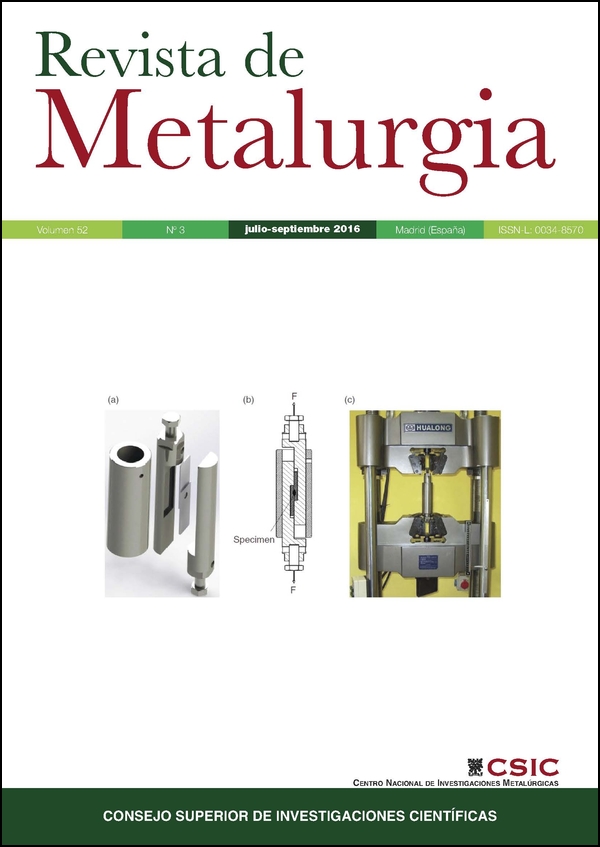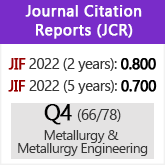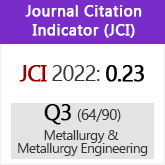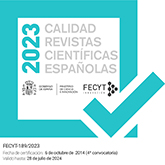An experimental study on fracture toughness of resistance spot welded galvanized and ungalvanized DP 450 steel sheets used in automotive body
DOI:
https://doi.org/10.3989/revmetalm.072Keywords:
DP steels, Fatigue, Fracture Toughness, Resistance Spot Welding (RSW)Abstract
The purpose of this study is to determine fracture toughness of Resistance Spot Welded (RSW) Dual Phase (DP) steels. RSW of galvanized and ungalvanized DP 450 steel sheets was carried out on spot welding machine. Fracture toughness of RSW joints of galvanized and ungalvanized DP 450 steel sheets was calculated from tensile-shear tests. New empirical equations were developed using Least Squares Method (LSM) between energy release rate, fracture toughness and critical crack size depending on the relationship between hardness and fracture toughness values. Results indicated that fracture toughness of joints welded by using RSW increased exponentially while the hardness decreased. In addition, fracture toughness and energy release rate of RSW galvanized DP 450 steel sheets were lower compared to RSW ungalvanized DP 450 steel sheets which had approximately the same hardness.
Downloads
References
Aslanlar, S. (2006). The effect of nucleus size on mechanical properties in electrical resistance spot welding of sheets used in automotive industry. Mater. Design 27 (2), 125–131. http://dx.doi.org/10.1016/j.matdes.2004.09.025
Aslanlar, S., Ogur, A., Ozsarac, U., Ilhan, E. (2008). Welding time effect on mechanical properties of automotive sheets in electrical resistance spot welding. Mater. Design 29 (7), 1427–1431. http://dx.doi.org/10.1016/j.matdes.2007.09.004
Broek, D. (1976). Elementary Engineering Fracture Mechanics, Noordhoff International Publishing, Neyden.
Chan, K.S. (2010). Roles of microstructure in fatigue crack initiation. Int. J. Fatigue 32 (9), 1428–1447. http://dx.doi.org/10.1016/j.ijfatigue.2009.10.005
Dowell, D.L., Dunne, F.P.E. (2010). Microstructure-sensitive computational modeling of fatigue crack formation. Int. J. Fatigue 32 (9), 1521–1542. http://dx.doi.org/10.1016/j.ijfatigue.2010.01.003
Eisazadeh, H., Hamedi, M., Halvaee, A. (2010). New parametric study of nugget size in resistance spot welding process using finite element method. Mater. Design 31 (1), 149–157. http://dx.doi.org/10.1016/j.matdes.2009.06.042
Gahr Zum, K.H. (1987). Microstructure and Wear of Material, Elsevier Science Publishers B.V., Amsterdam.
Hayat, F., Sevim, I. (2012). The effect of welding parameters on fracture toughness of resistance spot-welded galvanized DP600 automotive steel sheets. Int. J. Adv. Manuf. Tech. 58 (9), 1043–1050. http://dx.doi.org/10.1007/s00170-011-3428-x
Kang, H., Barkey, M.E., Lee, Y. (2000). Evaluation of multiaxial spot weld fatigue parameters for proportional loading. Int. J. Fatigue 22 (8), 691–702. http://dx.doi.org/10.1016/S0142-1123(00)00037-2
Kocabekir, B., Kaçar, R., Gündüz, S., Hayat, F. (2008). An effect of heat input, weld atmosphere and weld cooling conditions on the resistance spot weldability of 316L austenitic stainless steel. J. Mater. Process. Tech. 195 (1-3), 327–335. http://dx.doi.org/10.1016/j.jmatprotec.2007.05.026
Kulekci, M.K., Mendi, F., Sevim, I., Ba?türk, O. (2005). Fracture toughness of friction stir welded joints of AlCu4SiMg aluminium alloy. Metalurgija 44 (3), 209–213.
Kulekci, M.K., Sevim, I., Esme, U. (2012). Fracture Toughness of Friction Stir-Welded Lap Joints of Aluminum Alloys. J. Mater. Eng. Perform. 21 (7), 1260–1265. http://dx.doi.org/10.1007/s11665-011-0017-y
Lawn, B. (1993). Fracture of Brittle Solids, 2nd Edition, Cambridge University Press, Cambridge. http://dx.doi.org/10.1017/CBO9780511623127 PMCid:PMC45874
Lee, H., Kim, N., (2004). Fatigue life prediction of multi-spot-welded panel structures using an equivalent stress intensity factor. Int. J. Fatigue 26 (4), 403–412. http://dx.doi.org/10.1016/j.ijfatigue.2003.07.001
Ma, C., Chen, D.L., Bhole, S.D., Boudreau, G., Lee, A., Biro, E. (2008). Microstructure and fracture characteristics of spot-welded DP600 steel. Mat. Sci. Eng. A-Estruct. 485 (1-2), 334–346. http://dx.doi.org/10.1016/j.msea.2007.08.010
Müftüoglu, F., Keskinel, T. (2007) Effect of Coating Thickness on Electrode Life in the Spot Welding of Galvanized Steels. Turkish J. Eng. Env. Sci. 31 (3), 183–187.
Pan, N., Sheppard, S. (2002). Spot welds fatigue life prediction with cyclic strain range. Int. J. Fatigue 24 (5), 519–528. http://dx.doi.org/10.1016/S0142-1123(01)00157-8
Pook, L.P. (1975). Fracture Mechanics Analysis of the Fatigue Behavior of Spot Welds. Int. J. Fracture 11 (1), 173–176. http://dx.doi.org/10.1007/BF00034726
Sevim, I. (2005). Fracture Toughness of Spot-Welded Steel Joints. Kovove Mater. 43 (2), 113–125.
Sevim, I. (2006). Effect of hardness to fracture toughness for spot welded steel sheets. Mater. Design 27 (1), 21-30. http://dx.doi.org/10.1016/j.matdes.2004.09.008
Sevim, I., Hayat, F., Kulekci, M.K. (2013). Nucleus geometry and mechanical properties of resistance spot welded coated– uncoated DP automotive steels. B. Mater. Sci. 36 (6), 1049–1055. http://dx.doi.org/10.1007/s12034-013-0559-8
Sun, X., Stephens, E.V., Khaleel, M.A. (2007). Fatigue behaviors of self-piercing rivets joining similar and dissimilar sheet metals. Int. J. Fatigue 29 (2), 370–386. http://dx.doi.org/10.1016/j.ijfatigue.2006.02.054
Vural, M., Akkus, A. (2004). On the resistance spot weldability of galvanized interstitial free steel sheets with austenitic stainless steel sheets. J. Mater. Process. Tech. 153-154, 1–6. http://dx.doi.org/10.1016/j.jmatprotec.2004.04.063
Vural, M., Akkus, A., Eryurek, B. (2006). Effect of welding nugget diameter on the fatigue strength of the resistance spot welded joints of different steel sheets. J. Mater. Process. Tech. 176 (1-3), 127–132. http://dx.doi.org/10.1016/j.jmatprotec.2006.02.026
Zhang, X.Q., Chen, G.L., Zhang, Y.S. (2008). Characteristics of electrode wear in resistance spot welding dual-phase steels. Mater. Design 29 (1), 279–283 . http://dx.doi.org/10.1016/j.matdes.2006.10.025
Published
How to Cite
Issue
Section
License
Copyright (c) 2016 Consejo Superior de Investigaciones Científicas (CSIC)

This work is licensed under a Creative Commons Attribution 4.0 International License.
© CSIC. Manuscripts published in both the printed and online versions of this Journal are the property of Consejo Superior de Investigaciones Científicas, and quoting this source is a requirement for any partial or full reproduction.All contents of this electronic edition, except where otherwise noted, are distributed under a “Creative Commons Attribution 4.0 International” (CC BY 4.0) License. You may read here the basic information and the legal text of the license. The indication of the CC BY 4.0 License must be expressly stated in this way when necessary.
Self-archiving in repositories, personal webpages or similar, of any version other than the published by the Editor, is not allowed.


















